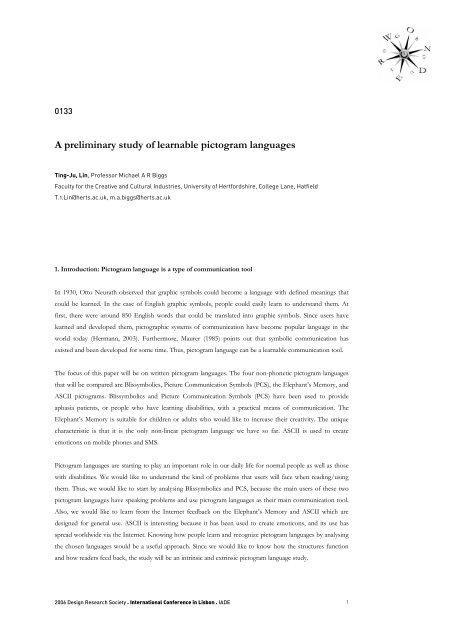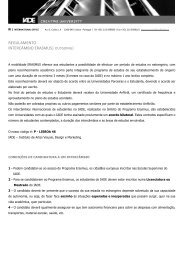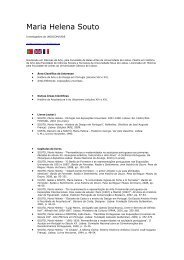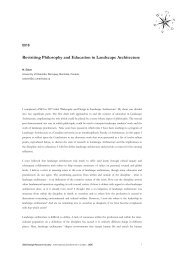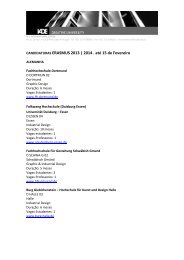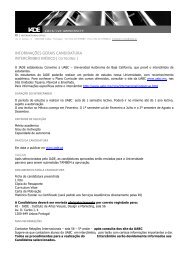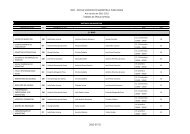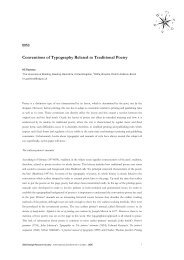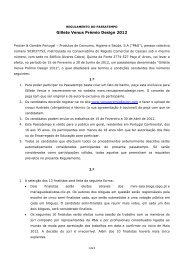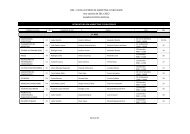A preliminary study of learnable pictogram languages - University of ...
A preliminary study of learnable pictogram languages - University of ...
A preliminary study of learnable pictogram languages - University of ...
Create successful ePaper yourself
Turn your PDF publications into a flip-book with our unique Google optimized e-Paper software.
0133<br />
A <strong>preliminary</strong> <strong>study</strong> <strong>of</strong> <strong>learnable</strong> <strong>pictogram</strong> <strong>languages</strong><br />
Ting-Ju, Lin, Pr<strong>of</strong>essor Michael A R Biggs<br />
Faculty for the Creative and Cultural Industries, <strong>University</strong> <strong>of</strong> Hertfordshire, College Lane, Hatfield<br />
T.1.Lin@herts.ac.uk, m.a.biggs@herts.ac.uk<br />
1. Introduction: Pictogram language is a type <strong>of</strong> communication tool<br />
In 1930, Otto Neurath observed that graphic symbols could become a language with defined meanings that<br />
could be learned. In the case <strong>of</strong> English graphic symbols, people could easily learn to understand them. At<br />
first, there were around 850 English words that could be translated into graphic symbols. Since users have<br />
learned and developed them, pictographic systems <strong>of</strong> communication have become popular language in the<br />
world today (Hermann, 2003). Furthermore, Maurer (1985) points out that symbolic communication has<br />
existed and been developed for some time. Thus, <strong>pictogram</strong> language can be a <strong>learnable</strong> communication tool.<br />
The focus <strong>of</strong> this paper will be on written <strong>pictogram</strong> <strong>languages</strong>. The four non-phonetic <strong>pictogram</strong> <strong>languages</strong><br />
that will be compared are Blissymbolics, Picture Communication Symbols (PCS), the Elephant’s Memory, and<br />
ASCII <strong>pictogram</strong>s. Blissymbolics and Picture Communication Symbols (PCS) have been used to provide<br />
aphasia patients, or people who have learning disabilities, with a practical means <strong>of</strong> communication. The<br />
Elephant’s Memory is suitable for children or adults who would like to increase their creativity. The unique<br />
characteristic is that it is the only non-linear <strong>pictogram</strong> language we have so far. ASCII is used to create<br />
emoticons on mobile phones and SMS.<br />
Pictogram <strong>languages</strong> are starting to play an important role in our daily life for normal people as well as those<br />
with disabilities. We would like to understand the kind <strong>of</strong> problems that users will face when reading/using<br />
them. Thus, we would like to start by analysing Blissymbolics and PCS, because the main users <strong>of</strong> these two<br />
<strong>pictogram</strong> <strong>languages</strong> have speaking problems and use <strong>pictogram</strong> <strong>languages</strong> as their main communication tool.<br />
Also, we would like to learn from the Internet feedback on the Elephant’s Memory and ASCII which are<br />
designed for general use. ASCII is interesting because it has been used to create emoticons, and its use has<br />
spread worldwide via the Internet. Knowing how people learn and recognize <strong>pictogram</strong> <strong>languages</strong> by analysing<br />
the chosen <strong>languages</strong> would be a useful approach. Since we would like to know how the structures function<br />
and how readers feed back, the <strong>study</strong> will be an intrinsic and extrinsic <strong>pictogram</strong> language <strong>study</strong>.<br />
2006 Design Research Society . International Conference in Lisbon . IADE 1
There are conflicting schools <strong>of</strong> thought as to how <strong>learnable</strong> or useful are these <strong>languages</strong>. Muter and Johns<br />
(Muter, 1985) stated that <strong>pictogram</strong> <strong>languages</strong> might be easier to learn than alphabet based <strong>languages</strong> in a wide<br />
range <strong>of</strong> situations. In their experiments they used Chinese, Blissymbolics and English characters as examples.<br />
They also pointed out that technology might make an increased use <strong>of</strong> <strong>pictogram</strong>s in the future.<br />
On the other hand, John DeFrancis and J. Marshall Unger argue that <strong>pictogram</strong> <strong>languages</strong> are impossible to<br />
learn and practice. In their article, ‘Rejoinder to Ge<strong>of</strong>frey Sampson, "Chinese script and the diversity <strong>of</strong> writing<br />
systems"’ (DeFrancis, 1994), they asserted that:<br />
We note too that first <strong>languages</strong> are naturally ACQUIRED by human beings, unlike second <strong>languages</strong><br />
and literacy, which must be LEARNED. From these elementary considerations, it is clear that an<br />
indefinite increase in the ‘expressive potential’ <strong>of</strong> partial writing is impossible: because it is essentially ad<br />
hoc, the system eventually becomes un<strong>learnable</strong> and impractical… And for the same reason that codes<br />
(unlike cipher) are secure unless the codebook is captured, pure or nearly pure logographic writing<br />
systems are un<strong>learnable</strong> and impractical.<br />
In their paper, they omitted the practical <strong>pictogram</strong> <strong>languages</strong>, such as Blissymbolics, PCS or other similar ones<br />
which are proving to be so popular and helpful to disabled writers.<br />
2. Examples <strong>of</strong> non-phonetic <strong>pictogram</strong> language: Blissymbolics, Picture Communication Symbols,<br />
the Elephant’s Memory, and ASCII<br />
2.1.Blissymbolics<br />
2.1.1 History<br />
The creator, Charles K. Bliss, created an easy-to-learn international auxiliary language to allow communication<br />
between people who do not speak the same language. Since the 1960s, Blissymbolics have become popular as a<br />
method <strong>of</strong> Augmentative and Alternative Communication (AAC) for non-speaking people with a variety <strong>of</strong><br />
disorders, for whom it can be impossible to communicate by other means. Blissymbolics Communication<br />
International (BCI) dates its usage from 1971, and standard Blissymbolics language structure and vocabulary is<br />
based on and derived from Bliss’ work ‘Semantography’ (1949). BCI developed Blissymbolics in accordance<br />
with the needs <strong>of</strong> its users, which include:<br />
• National, cultural, and developmental differences;<br />
• The maintenance <strong>of</strong> the logic <strong>of</strong> the system;<br />
• The maintenance <strong>of</strong> Blissymbolics as a multicultural language;<br />
• Sensitivity to the practical and pragmatic needs for communication.<br />
(The fundamental rules <strong>of</strong> Blissymbolics: creating new Blissymbolics characters and vocabulary,<br />
2004)<br />
2006 Design Research Society . International Conference in Lisbon . IADE 2
By supporting the needs <strong>of</strong> certain people for daily life and adapting to the development <strong>of</strong> technology, BCI<br />
also helps to create or develop new words and the use <strong>of</strong> computers as a communication tool. In other words,<br />
BCI considers that Blissymbolics is a living language, continuing to create new vocabulary. Therefore, explicit<br />
guidelines are necessary to ensure precision and accuracy in those Blissymbolics comprising the BCI<br />
Authorized Vocabulary. Moreover, computer implementation imposes certain restrictions which can be met<br />
more easily by following an explicit set <strong>of</strong> guidelines.<br />
2.1.2 Elements<br />
Blissymbolics is an ideographic writing system consisting <strong>of</strong> several hundred basic symbols, each representing a<br />
concept, which can be combined together to generate new symbols that represent new concepts. There had<br />
not been enough graphic objects to express new digital information before, so the Blissymbolics system has<br />
created new ones, such as ‘email’. Most <strong>of</strong> the objects are created using abstract elements and the system has a<br />
robust structure, so that new objects are easy to create and people can read them quickly if they know the rules<br />
<strong>of</strong> the representation. If people can’t understand the basic rules or composition the first time, it might be<br />
difficult for the readers to understand these ideas, since Blissymbolics is created from abstract graphics. There<br />
are some examples <strong>of</strong> frequent words below. All the figures <strong>of</strong> Blissymbolics come from The fundamental rules <strong>of</strong><br />
Blissymbolics: creating new Blissymbolics characters and vocabulary(2004), besides Figure 9.<br />
Figure 1 Symbols <strong>of</strong> Blissymbolics<br />
As you see, Blissymbolics may also appear to be combined with other Bliss-characters to form other words.<br />
These kinds <strong>of</strong> word combinations can help readers to learn them more quickly and effectively. Even people,<br />
who just know the basic <strong>pictogram</strong>s, once they know the rules <strong>of</strong> creating new <strong>pictogram</strong>s, will get the<br />
meaning by linking the relationships between <strong>pictogram</strong>s. A ‘house’ and a ‘medical’ <strong>pictogram</strong>, for example,<br />
represent a ‘hospital’, and when a ‘house’ goes with a ‘money’ symbol that means a ‘bank’.<br />
Figure 2 Symbols-expanding<br />
Blissymbolics consist <strong>of</strong> black-and-white lines and simple elements without colour and other complexities such<br />
as a shadow. Thus it is graphic.<br />
2006 Design Research Society . International Conference in Lisbon . IADE 3
The formatting position on the page is important in BCS. Therefore, size, angle, direction, and position play<br />
important roles as well.<br />
Figure 3 The basic guideline <strong>of</strong> Blissymbolics symbol<br />
The recent development <strong>of</strong> BCS s<strong>of</strong>tware means that if the position or space <strong>of</strong> a <strong>pictogram</strong> is incorrect, its<br />
meaning can’t be recognized by the computer.<br />
Figure 4 The position <strong>of</strong> Blissymbolics<br />
Size is another grammatical structure. For example, both sun and mouth are shown as a circle, but the size is<br />
the key point that distinguishes them.<br />
Figure 5 Size <strong>of</strong> Blissymbolics<br />
2006 Design Research Society . International Conference in Lisbon . IADE 4
In Blissymbolics, additional signs are very important to help create new <strong>pictogram</strong>s, such as punctuation<br />
marks, arrows, and ‘<br />
’. Once we know the rules <strong>of</strong> size, position etc, when we read the<br />
following <strong>pictogram</strong>s, we find that it is easier to remember their meanings The ‘<br />
and ‘<br />
’ shows which part <strong>of</strong> the body’s being referred.<br />
’ represents the body,<br />
Figure 6 Additional signs <strong>of</strong> Blissymbolics<br />
Another style <strong>of</strong> directing relationship between signs is using a set <strong>of</strong> signs, like ‘)’ and ‘(’.<br />
Figure 7 Additional signs <strong>of</strong> Blissymbolics<br />
2.1.3 Structure<br />
In Blissymbolics, space and position are two key points. Thus, when users present a sentence, each <strong>pictogram</strong><br />
should be put in its right place. For example, the punctuation marks have to be put in the front <strong>of</strong> all<br />
<strong>pictogram</strong>s.<br />
Figure 8 Presentation <strong>of</strong> Blissymbolics<br />
In this system, its structure is linear but shows expression clearly and directly. For instance, there is a “?”sign in<br />
front <strong>of</strong> a questioning sentence or a “!” at the beginning <strong>of</strong> a <strong>pictogram</strong> that express surprise or wonder. It uses<br />
combinations <strong>of</strong> symbols to describe attributes.<br />
2006 Design Research Society . International Conference in Lisbon . IADE 5
Please return my money!<br />
Welcome to my home.<br />
How are you?<br />
Figure 9 The Bliss sentences: http://www.symbols.net/blissymbolics/phrases1/<br />
A sign is shown in front <strong>of</strong> a sentence and shows its attributes by different marks; in this case it is similar to<br />
English. So, the attributes in this system are very clearly organized.<br />
When users want to present comparative ideas, Blissymbolics adds ‘<br />
’ to this <strong>pictogram</strong>.<br />
Figure 10 Comparative sings <strong>of</strong> Blissymbolics<br />
2.2 PCS (Picture Communication Symbols)<br />
2.2.1 History<br />
PCS is an abbreviation <strong>of</strong> Picture Communication Symbols. It originated in the United States as three<br />
photocopy files containing symbols divided into sections, such as people, verbs, descriptive, nouns, and so on.<br />
This refers to a set <strong>of</strong> symbols composed ‘primarily <strong>of</strong> simple lines with printed words above them’ (Lloyd et<br />
al., 1997, p.537). They comprised a pictographic symbol set with a large number <strong>of</strong> symbols, which would<br />
allow the depiction <strong>of</strong> a broad array <strong>of</strong> concepts (Mayer-Johnson, 1984, 1985).<br />
The aim <strong>of</strong> PCS is to provide symbol-based products, training and services for individuals with special needs.<br />
Nowadays, approximately 10,000 PCS symbols are available in 40 <strong>languages</strong> like German and Chinese, and it is<br />
used worldwide.<br />
2006 Design Research Society . International Conference in Lisbon . IADE 6
The objective <strong>of</strong> the system is to enable those persons whose speech is unintelligible or nonexistent to<br />
communicate with others. This can involve sign language, the written word, picture symbols, and other aids<br />
and techniques. Devices are available that are dedicated to enhance communication. Many <strong>of</strong> these devices<br />
include voice and scanning capabilities. The symbols are more colourful than other <strong>pictogram</strong> <strong>languages</strong><br />
although some symbols are black-and-white. Many symbols are more representational, as when human facial<br />
expressions are used instead <strong>of</strong> abstract graphics. For example, when the meaning is, ‘like’, the symbol is a<br />
‘smiley face’ not a graphic symbol for ‘heart’.<br />
PCS needs s<strong>of</strong>tware to form sentences, and also "Boardmaker", "Talking Screen" and "Writing with Symbols".<br />
Boardmaker is a tool which contains Picture Communication Symbols (PCS) in bitmap format for<br />
communication and learning. All the examples <strong>of</strong> PCS come from http://www.mayerjohnson.com/default.aspx<br />
in 2004.<br />
Figure 11 The use <strong>of</strong> Picture Communication Symbols<br />
2.2.2 Elements<br />
The original Boardmaker programme was developed by staff at the Erinoak Hospital in Canada. There are<br />
now approximately 8,000 individual picture symbols available in many different formats. They have been<br />
translated into many <strong>languages</strong> and are being developed constantly. Also, it uses many gestures and arrows to<br />
represent ideas. Thus, we can say that PCS <strong>pictogram</strong>s contain both representational and abstract features. For<br />
example, ‘is’ and ‘are’ might be presented by ‘=’. It can be represented both in computer and printing media.<br />
People can use Boardmaker to display their ideas with the <strong>pictogram</strong>s.<br />
2006 Design Research Society . International Conference in Lisbon . IADE 7
Figure 12 Boardmaker <strong>of</strong> PCS<br />
As in the example below, if we don’t use the individual symbols, the <strong>pictogram</strong>s <strong>of</strong> football game become two<br />
<strong>pictogram</strong>s - football and game.<br />
Figure 13 Association with ‘words’<br />
PCS is a more effective and user friendly communication tool than other fixed <strong>pictogram</strong> <strong>languages</strong> as it <strong>of</strong>fers<br />
more choices.<br />
Figure 14 Pictograms with same meanings<br />
Writing with Symbols allows you to mix the symbols from more than one set, allowing you to use the image<br />
that the user prefers, rather than being restricted to a single set.<br />
2006 Design Research Society . International Conference in Lisbon . IADE 8
Figure 15 PCS sentence<br />
2.2.3 Structure<br />
The structure is linear, like spoken language, and so it expresses meaning by consecutive symbols. Sometimes<br />
one symbol might represent one “meaning” rather than one word. In this view, it is very different from<br />
Blissymbolics. For instance, the phrase ‘How are you?’ is represented by using just one combined picture<br />
which consists <strong>of</strong> a question mark and the graphic for gesture.<br />
Figure 16 PCS sentences<br />
It also uses arrows to represent time. Using facial expressions or pronunciation to show the emotion <strong>of</strong> the<br />
sentences is its characteristic. For instance, if there is a ‘W~’ in front <strong>of</strong> one sentence, this means ‘would’ and<br />
the sentence becomes a question.<br />
The structure <strong>of</strong> the system basically follows spoken English, but it might be developed or modified to suit<br />
another western language easily. It uses lots <strong>of</strong> gestures so that people who can read gestural language might be<br />
able to learn it more quickly. The colourful symbols might be attractive to children, since the symbols are vivid<br />
to attract the reader’s eyes. PCS could also be presented in black and white, and users can decide what kind <strong>of</strong><br />
style they want to see.<br />
2006 Design Research Society . International Conference in Lisbon . IADE 9
Figure 17 Presentation in black and white<br />
2.3. The Elephant’s Memory<br />
2.3.1 History<br />
The Elephant's Memory was created by Timothee Ingen-Housz between 1996 and 1998. Ingen-Housz is a<br />
French-Dutch artist who works in the expanding field <strong>of</strong> media arts. He discovered the Internet and started<br />
working on a pictorial language in 1993. After two years, he attended the Academy <strong>of</strong> Media Arts, Cologne,<br />
Germany (Timothee Ingen-Housz , 1999).<br />
In this language system, the keyboard-based s<strong>of</strong>tware requires the ability to transform graphic objects (in size,<br />
orientation, and position) and create hyperlinked documents that are potentially attached to audiovisual files. A<br />
global environment harmonizing a tutorial and a functional workspace is then required.<br />
The Elephant’s Memory consists <strong>of</strong> about 200 symbols and icons, which can be combined in order to create<br />
sentences.<br />
The aim <strong>of</strong> the system is “to set up an experimental research environment which gathers a community <strong>of</strong> users<br />
to explore the field <strong>of</strong> invented <strong>languages</strong> and the questions orbiting around their form, structure, and<br />
development process”, especially for children. In other words, it tries to <strong>of</strong>fer students and educators the<br />
ability to search for new ways <strong>of</strong> envisioning communication. They can be rendered on a laptop or projected<br />
onto a giant screen, and they will be equally recognizable and identifiable. Their rounded shapes create a<br />
homogenous style that sets the visual identity <strong>of</strong> the language and makes them attractive to children. They can<br />
be rendered in a simulated 3D effect to give more solidity and to be manipulated.<br />
2.3.2 Elements<br />
It consists <strong>of</strong> more than 200 combinable graphic objects so far, and continues to develop. Most <strong>of</strong> the<br />
elements are created from several basic ideas; for instance, a circle means ‘all’. When the <strong>pictogram</strong> is added a<br />
‘cross’, it means the opposite idea. The example figures <strong>of</strong> the Elephant’s Memory all come from Ingen-<br />
Housz, Timothee (1999). The Elephant's Memory.<br />
2006 Design Research Society . International Conference in Lisbon . IADE 10
Figure 18 Symbol-expanding<br />
Once the basic <strong>pictogram</strong> is fixed, more and more related ideas can be developed from the essential one.<br />
Housz described these as ‘linked logograms’.<br />
Figure 19 Symbol-expanding<br />
Another way <strong>of</strong> developing <strong>pictogram</strong>s is to extend the basic ones. So the symbol for ‘me’ can be expanded to<br />
‘you’, and ‘someone’. ‘Me’, ‘you’ and ‘someone’ are personal pronouns; by modifying ‘me’, the first personal<br />
pronoun, the later ones will be understood easily, because the one I talk to, or the one I face, is ‘you’. The third<br />
personal pronoun means the one I talk about without facing. This kind <strong>of</strong> expression <strong>of</strong> a basic symbolexpanding<br />
idea is also used not only in Blissymbolics, but also in Chinese. Therefore, people can learn the<br />
elements more quickly and effectively with expanding symbols.<br />
2006 Design Research Society . International Conference in Lisbon . IADE 11
Figure 20 Symbol-expanding<br />
2.3.3 The structure<br />
Ingen-Housz stated that the Elephant’s Memory is a non-linear language enabling people to read and write in<br />
every direction, starting and ending from any component <strong>of</strong> a sentence. The messages can be written and read<br />
starting from any place in the composition.<br />
Each <strong>of</strong> the logograms <strong>of</strong> The Elephant’s Memory features an associative structure defined by its form and<br />
meaning. In addition, it uses ‘position’ and ‘size’ to represent their association. Like the examples below, if the<br />
sentence wants to show the personal pronoun ‘I’, then the <strong>pictogram</strong> ‘I’ will be bigger than the other<br />
<strong>pictogram</strong>s.<br />
2006 Design Research Society . International Conference in Lisbon . IADE 12
Figure 21 Position and size in sentences<br />
Another example <strong>of</strong> representing ‘to’ (or ‘by’) and ‘from’ in The Elephant’s Memory is given below.<br />
Figure 22 Direction <strong>of</strong> presentation<br />
The arrow can show the basic idea <strong>of</strong> direction. This enables the readers to get the hints clearly when they see<br />
it in one ‘sentence’. The <strong>pictogram</strong> sentence below shows the way in which ‘to’ or ‘by’ is used.<br />
Figure 23 Direction in sentences<br />
2006 Design Research Society . International Conference in Lisbon . IADE 13
In the <strong>pictogram</strong> language system, the main idea or the most important element in one sentence will be put in<br />
the central position, not only made bigger. Sometimes, a verb plays a leading role in one sentence, and the<br />
<strong>pictogram</strong> might be shown both bigger and put in the middle <strong>of</strong> the ‘whole’ or the group <strong>of</strong> <strong>pictogram</strong>s. As<br />
when the verb is ‘exchange’, the <strong>pictogram</strong> is as below.<br />
Figure 24 ‘Exchange’ <strong>pictogram</strong><br />
If the term ‘exchange’ is more important than the other elements in the sentence or the author wants to stress<br />
the verb, it might look like the image below:<br />
Figure 25 ‘Exchange’ in sentence<br />
Both the “The Elephant’s Memory” and “Blissymbolics” use direction to express tense. For example, the<br />
former system uses the signs and to show the tense <strong>of</strong> past and future. The<br />
latter system uses “)” and “(” to show the same thing. Two examples explaining the use <strong>of</strong> tenses in The<br />
Elephant’s Memory here are ‘The house was burning.’ and ‘I will drive to the forest’:<br />
2006 Design Research Society . International Conference in Lisbon . IADE 14
Figure 26 Presentation <strong>of</strong> tense<br />
From these sentences, a reader can feel that when s/he reads the <strong>pictogram</strong>s, his/her eyes will be attracted to<br />
the bold <strong>pictogram</strong> that shows the verb.. After that, the reader will organize the relationships between the<br />
<strong>pictogram</strong>s by direction and size <strong>of</strong> the <strong>pictogram</strong>s.<br />
To emphasize the importance <strong>of</strong> the linear effect in the Elephant’s Memory, there are some instances which<br />
are more complicated than those above. Thus, readers may be affected by the non-linear idea from the<br />
<strong>pictogram</strong> language. The <strong>pictogram</strong>, which shows ‘while’ or ‘at the same time’ is ‘ ’.<br />
Figure 27 Presentation <strong>of</strong> ‘non-linear’ idea<br />
A reader might read each ‘level’ group <strong>of</strong> <strong>pictogram</strong>s first, and then combine the ideas together after checking<br />
the whole <strong>pictogram</strong>. In other words, each <strong>pictogram</strong> will be read at least twice. They will be seen, classified,<br />
connected, integrated and checked again at the end. The reader’s eyes will not see these <strong>pictogram</strong>s in a ‘linear’<br />
2006 Design Research Society . International Conference in Lisbon . IADE 15
way, such as when reading an alphabet paragraph. Therefore, the Elephant’s Memory is a good example for<br />
discussing linearity in <strong>pictogram</strong> <strong>languages</strong>.<br />
The Elephant’s Memory doesn’t have a written set <strong>of</strong> syntactic rules, like the Bliss symbols, and it is vaguely<br />
defined, which leaves much more room for ambiguity (Hermann, 2003). This is a strength and also might be a<br />
weakness. The advantage is that users can create more sentences without a complete fixed rule. On the other<br />
hand, it might confuse the readers.<br />
2.4. ASCII/SMS<br />
2.4.1 The history<br />
ASCII/SMS <strong>pictogram</strong>s are based on the use <strong>of</strong> the standard ASCII characters on the keyboard. At first, it<br />
only uses the keys from the normal keyboard to represent characters but this has now progressed so that the<br />
use <strong>of</strong> ‘extended’ character codes is a common occurrence. ASCII images can be created via s<strong>of</strong>tware and<br />
extended characters can turn up on differing systems (Dougaev 1999; Geroch, 2001).<br />
People have used the keyboard to express art through the given characters since the beginning <strong>of</strong> computer<br />
communication, from the smile ’:)’ to extreme photo-realistic digitisations <strong>of</strong> portraits. At first, ASCII/SMS<br />
was typed in on a bulletin board. On a bulletin board, there were no other icons to express the users’ thoughts<br />
or feelings. When emotion <strong>pictogram</strong>s appeared, they helped users to show their emotions. Since users’ ideas<br />
could be represented more clearly and readers could get more hints from the ASCII/SMS, the character was<br />
thought to <strong>of</strong>fer an additional <strong>pictogram</strong> language function.<br />
2.4.2 The elements<br />
Nanette Wylde is a cultural worker who is interested in language, personality, ideas, systems, perceptions,<br />
structures, stories, and context. She teaches electronic arts at California State <strong>University</strong>. She believed that<br />
standard ASCII art is made with characters, such as: 1 2 3 4 5 6 7 8 9 0 a b c d e f g h i j k l m n o p q r s t u v<br />
w x y z A B C D E F G H I J K L M N O P Q R S T U V W X Y Z \ | - _ + % @ < ; ! = # . , : > ( ] / & $ ^<br />
' ` " ~ ) [ { } ? * . These characters are part <strong>of</strong> the ASCII (America Standard Code for Information<br />
Interchange) keyboard. This part <strong>of</strong> the ASCII set is called the 'printable set'. Before computers, ASCII art was<br />
produced on typewriters and teletype machines, and was also created typographically.<br />
ASCII art is used because “Standard ASCII art is the only type <strong>of</strong> graphics easily transmitted and instantly<br />
viewable on any terminal, reproduction, or communications s<strong>of</strong>tware.” (Geroch, 2001).<br />
Even if people use the same keyboard, they might use different characters to compose the same idea. For<br />
example, in the fifth style emotion <strong>pictogram</strong>s, the ‘eyes’ could be replaced by similar characters. Typing in<br />
other <strong>languages</strong>, such as Chinese (Traditional and Simplified), Japanese, and Korean (Hangeul) may require<br />
more than 256 characters, so that even users who are not familiar with other language systems, such as English<br />
ASCII, can also use the keyboard to make their own ASCII <strong>pictogram</strong>s.<br />
2006 Design Research Society . International Conference in Lisbon . IADE 16
1 2 3 4 5 6 7<br />
ω <br />
?? ?? ?? ?ω? ?? ?? ??<br />
∩∩ ∩∩ ∩∩ ∩ω∩ ∩∩ ∩∩ ∩∩<br />
●● ●● ●● ●ω● ●● ●● ●●<br />
ω <br />
Figure 28 Emoticons<br />
Typing with the same keyboard operations will show the same idea with different characters. For example,<br />
people can represent a ‘mouth’ <strong>of</strong> a emotion face via ‘’ or ‘0’ or ‘^’ or ‘ω’ or ‘﹏’ or ‘’, and they might<br />
show ‘anger’ as ‘^’ or ‘^’ or ‘^’.<br />
2.4.3 The structure<br />
ASCII was created and is currently used in the computer or Internet environment. People can design new<br />
images by typing on the keyboard. In other words, this ASCII language is completely composed <strong>of</strong><br />
alphanumerics and certain punctuation.<br />
ASCII…The most widely used standard for defining the meaning <strong>of</strong> each the meaning <strong>of</strong> each <strong>of</strong> the<br />
possible 256 bit patterns is called ASCII (an acronym standing for the American Standard Code for<br />
information Interchange). ASCII is a special kind <strong>of</strong> code that allows us to use binary numbers to<br />
represent characters, punctuation, numbers, or even predefined graphics characters.<br />
( Hannah, S. A. 1994). "ASCII: A character <strong>study</strong>." Computers in Libraries 14(9): 26.)<br />
So, the quality <strong>of</strong> ASCII can contain both a western writing system and a graphical language. The presentation<br />
<strong>of</strong> the structure could be as below:<br />
I am very happy today :)<br />
Let me think a while ^^a…<br />
It was a bad experience @@~<br />
The emotion ASCII <strong>pictogram</strong>s can help users to express their feelings, and reduce ambiguity when they post a<br />
sentence on a bulletin board. The most common emotion ASCII <strong>pictogram</strong>s which are typed using an English<br />
keyboard are as follows:<br />
: + ) = ☺ smile<br />
: + ( = angry<br />
=.=! embarrassment<br />
>O< scream<br />
2006 Design Research Society . International Conference in Lisbon . IADE 17
:D laugh<br />
^^a… thinking<br />
@@~ cry with red eyes<br />
m(O)m kneel<br />
Different keyboard operations can be used to show same idea with different characters. For example, when the<br />
Japanese and traditional Chinese systems want to represent ‘unhappy’ or ‘thinking’, they can use their<br />
characters to compose the emotion <strong>pictogram</strong>s. Users might recognize the emotion ASCII <strong>pictogram</strong>s more<br />
easily, since they don’t recognise the individual characters, like the Japanese ASCII shown below. Or, because<br />
more characters are represented in a <strong>pictogram</strong>, is it clearer to read the image? We might think about this and<br />
develop it into another issue later.<br />
Japanese<br />
he he no no mo he(keyboard)<br />
へ へ<br />
の の<br />
も<br />
へ<br />
Figure 29 Emoticons created by Japanese keyboard<br />
he he no no u nn (keyboard)<br />
へ へ<br />
の の<br />
う<br />
ん<br />
Figure 30 Emoticons created by Japanese keyboard<br />
Traditional Chinese phonetic symbols<br />
_<br />
ˇ_ˇ<br />
2006 Design Research Society . International Conference in Lisbon . IADE 18
_<br />
Most ASCII <strong>pictogram</strong>s are used as emotion symbols and as an additional function to sentences. However,<br />
users might also use ASCII to ‘write’ a short sentence, but the sentences might be too difficult for readers<br />
since they are too ambiguous.<br />
(@^0^@) How are you<br />
(>_ < ) / ( o ) ( ¯□¯ ) Wow…it happened, my mind is blank<br />
( ^^^ ) < ( _ _ ) > Sorry with a smile<br />
Besides using ASCII to present <strong>pictogram</strong>s, ASCII can be composed <strong>of</strong> a picture as well. Thus, users’ feelings<br />
or ideas might be expressed more clearly and exactly. In the instance below, a boy kissed a girl, so readers<br />
might feel the idea more vividly than one sentence which is added to an emotion <strong>pictogram</strong>.<br />
♂♂♂♀♀♀ \/\ / \<br />
/⁄⁄/ /\\\\ ▄▄\♂&♀<br />
? \// / \\ / \ │<br />
\\ ) > / ) ) \)\<br />
( ? _● ● /\__\<br />
\____/\___〉___/ ?<br />
Figure 32 Pictures created by ASCII<br />
To summarize, ASCII <strong>pictogram</strong>s can be added to the end <strong>of</strong> a sentence, or be shown as a complete image.<br />
Users can make <strong>pictogram</strong>s or images with ASCII as they send messages. Position and space alone <strong>of</strong>fer<br />
creators a flexible structure when they are expressed through ASCII.<br />
3. Methodology: two approaches- intrinsic and extrinsic<br />
3.1 Intrinsic: Comparative analysis and evaluation <strong>of</strong> linear and non-linear <strong>pictogram</strong> <strong>languages</strong><br />
People have used visual <strong>languages</strong> to record information, and for social communication. Many visual <strong>languages</strong><br />
are based on <strong>pictogram</strong> and signs, and many <strong>of</strong> them are still used nowadays. In other words, we have shared<br />
some <strong>pictogram</strong>s and structures for a long time. If one part <strong>of</strong> a system continues to be used, it implies that the<br />
communication tool is very easy to learn and has lots <strong>of</strong> readers. Foster and Afzalnia (2005, p.169-175)<br />
2006 Design Research Society . International Conference in Lisbon . IADE 19
concluded that from the evidence <strong>of</strong> different countries and cultures (United Kingdom, Korea, and Iran)<br />
communication systems can support the standardization <strong>of</strong> the meanings <strong>of</strong> symbols.<br />
Moreover, Nakamura, Newell, Alm, and Waller (1998: 71-80) found that the order <strong>of</strong> symbols in a sentence,<br />
which is based on English grammar, seriously affects Japanese speakers. Also, both Japanese and English<br />
speakers skip words when comparing reading <strong>pictogram</strong> language and speaking. This shows that exploring the<br />
structure and grammar <strong>of</strong> <strong>pictogram</strong> language is necessary as well. This kind <strong>of</strong> research focuses on linear<br />
<strong>pictogram</strong> <strong>languages</strong>. When talking about structure, non-linear <strong>languages</strong> should also be included. Here, the<br />
Elephant’s Memory is a good example <strong>of</strong> non-linearity.<br />
To sum up, if we can investigate and research <strong>pictogram</strong>s and structures, we might find common ground<br />
between the different <strong>pictogram</strong> <strong>languages</strong>. Furthermore, we might evaluate what kind <strong>of</strong> <strong>languages</strong> can be<br />
easy to learn.<br />
3.2 Extrinsic: Quantitative- Users’ feedback<br />
Nowadays, users’ feedback and the electronic media (Sasson, 1997) are involved the increasing development <strong>of</strong><br />
<strong>pictogram</strong> <strong>languages</strong>. For instance, Blissymbolics were initially designed by a few experts. Blissymbolics<br />
Communication International’s (BCI) guidelines consider that they should have more new ‘vocabularies’ to<br />
keep up with this era, so it welcomes feedback and the design <strong>of</strong> new symbols. The guide book, ‘The<br />
fundamental rules <strong>of</strong> Blissymbolics: creating new Blissymbolics Characters and Vocabulary’, explains this idea<br />
in its introduction:<br />
This document describes the basic structure <strong>of</strong> the Blissymbolics language, and outlines both the rules<br />
necessary to be followed for creating new BCI Authorized Vocabulary, as well as procedures used for<br />
adopting that vocabulary. This reference document will guide anyone wishing to use the Blissymbolics<br />
language. Its purpose is to ensure consistency and maintain the integrity <strong>of</strong> Blissymbolics as an<br />
international language.<br />
In other words, a <strong>pictogram</strong> language will face much more cultural and reading problems without users’<br />
feedback. If a <strong>pictogram</strong> language is to become more successful, and develop as an international language, it is<br />
essential that users share new symbol creations and discuss their successes through feedback. However,<br />
research projects that focus on <strong>pictogram</strong> language systems so far still exclude the ASCII system. ASCII has<br />
been used to represent pictures and sentences, on the other hand, and it is now used to create new <strong>pictogram</strong>s<br />
or exchange ideas between users. This means it can exist as a picture or icon added in a sentence, such as a<br />
smiley face being composed <strong>of</strong> ‘:’ and ‘)’, or it can represent a sentence which is composed <strong>of</strong> these kinds <strong>of</strong><br />
<strong>pictogram</strong>s, which are called emoticons.<br />
These emoticons could only be shown in text format before. Nowadays, more and more s<strong>of</strong>tware<br />
environments can transform these black and white ASCII emotion icons into colourful icons. In other words,<br />
if users key in these punctuation marks in an e-chat room or online systems, the result is converted from the<br />
2006 Design Research Society . International Conference in Lisbon . IADE 20
original text format like ‘:)’, as it was shown previously, into ‘☺’ automatically and it can be coloured as well.<br />
The most popular <strong>pictogram</strong>s are used in emoticons. To make users feel more comfortable and <strong>of</strong>fer them<br />
various personal <strong>pictogram</strong>s, <strong>pictogram</strong> language environments, like MSN, also updates their functions to<br />
allow users to save or exchange their own <strong>pictogram</strong>s.<br />
Furthermore, people may express emoticons by using various combinations in different cultures or areas. This<br />
situation also affects the database <strong>of</strong> emoticons. For example, a user can type ‘:)’ and ‘:-)’ to display smiley<br />
faces, and ‘;)’ and ‘;-)’ to reveal a blink. whichever version <strong>of</strong> the former or the latter a user keys in, the<br />
emoticons are represented by the same icon in an e-chat window via the database. We might say that<br />
<strong>pictogram</strong> <strong>languages</strong> have affected each other and might be integrated through a process <strong>of</strong> exchange.<br />
If the Internet brings <strong>pictogram</strong> users closer, the s<strong>of</strong>tware can allow users to change it, and be updated by their<br />
feedback. The development <strong>of</strong> emoticons in MSN messenger is an example. People can type popular text<br />
format emoticons like ‘:)’ or pick the emoticon which is an upright icon ‘☺’ in its conversation window. If the<br />
users are more familiar with getting a smiley face by keying in ‘:=)’, they can change the settings <strong>of</strong> smiley face<br />
at any time. Since users can manage and change all their emoticons data, everyone can be allowed to create<br />
their own smiley icons, even using their own portrait or drawings. Moreover, users can not only exchange or<br />
share the emoticons, but also store them for future use.<br />
Users can pick emoticons by clicking on one from the databank or by typing text. If users prefer typing a<br />
unique ASCII to get the emoticons, such as ‘^_____^’ to represent a smiley face, they can go back to the<br />
database and change the short cut keys to one they are used to. In this instance, the conventions <strong>of</strong> the<br />
principle <strong>of</strong> <strong>pictogram</strong> language come from user feedback.<br />
In addition, through interactivity in the Elephant’s Memory the emphasis is designed to be fleshed out with<br />
various s<strong>of</strong>tware applications. For example, the <strong>pictogram</strong> can be shown by a Quick Time movie, Word text,<br />
or an image. If <strong>pictogram</strong> <strong>languages</strong> can be shown via various media, there will be more chance <strong>of</strong> interchange<br />
and familiarity among users.<br />
To sum up, <strong>pictogram</strong> <strong>languages</strong> have expanded variously and have been affected by feedback from users. It is<br />
obvious that <strong>pictogram</strong> language has the potential become much more international, although we have seen<br />
that some have structures based on natural <strong>languages</strong>. In addition, the Internet <strong>of</strong>fers users an opportunity to<br />
communicate and exchange thoughts. Some <strong>pictogram</strong> <strong>languages</strong>, such as Blissymbolics, that are useful for<br />
disabled people, have been developed so that everyone can express their opinion through the creation <strong>of</strong> new<br />
symbols. For these reasons <strong>pictogram</strong> <strong>languages</strong> are being used far more frequently. Advice from feedback and<br />
the continuation <strong>of</strong> amendment could help <strong>pictogram</strong> <strong>languages</strong> become a writing system which most people<br />
can learn easily and quickly in daily life.<br />
2006 Design Research Society . International Conference in Lisbon . IADE 21
4.Conclusion<br />
4.1 Limits and possibilities <strong>of</strong> the <strong>study</strong><br />
Of course, there is no language that can truly be called an ‘international’ one. Culture, language structure,<br />
(Huer, 2000), definition <strong>of</strong> meanings and inherent ambiguity will make a universal language impossible (King,<br />
2000). Since the development <strong>of</strong> the new media there are more international communication choices for users.<br />
In addition, a strong and deep grammar structure and language intuition can help users learn it without too<br />
much difficulty. Thus, if we want to make a <strong>pictogram</strong> language more <strong>learnable</strong>, we have to understand the<br />
limits and possibilities outlined above. Hermann stated that there hasn’t been any research combining<br />
computers and original <strong>pictogram</strong>, and there have not been multiple settings <strong>of</strong> experiments with<br />
comprehension and representation either. From future studies analysing structures and feedback, we might<br />
discover how people think about and use <strong>pictogram</strong>s in order to communicate.<br />
4.2 Contribution<br />
The four <strong>pictogram</strong> <strong>languages</strong> share certain characteristics, from linearity to symbols themselves. Also, the four<br />
<strong>languages</strong> can be represented by computer. This facilitates a suitable environment in which to set experiments.<br />
It is useful to do comparative research into <strong>pictogram</strong> language learning.<br />
To make <strong>pictogram</strong>s easier to learn, we can integrate <strong>pictogram</strong>s from various <strong>languages</strong> and get feedback<br />
from users. Thus, research on ASCII <strong>pictogram</strong>s should be included. To understand the structure we can<br />
compare linear with non-linear <strong>pictogram</strong> <strong>languages</strong>, such as the Elephant’s Memory. This will <strong>of</strong>fer us far<br />
more data regarding approaches to real-world learning. In order to realize the limitations and potential <strong>of</strong> the<br />
individual <strong>pictogram</strong>s and structure, the best approach is to obtain feedback from users.<br />
To conclude, we believe that further research and its results can help <strong>pictogram</strong> language designers and users<br />
to break down communication barriers and promote understanding between different communities.<br />
Reference<br />
Blissymbolics Communication International (2004). The fundamental rules <strong>of</strong> Blissymbolics: creating new Blissymbolics characters and vocabulary Retrieved<br />
2004,at<br />
http://www.blissymbolics.org/downloads/blissrules.pdf#search='The%20fundamental%20rules%20<strong>of</strong>%20Blissymbolics%3A%20creating%20new%20Blissymbolics%20characters%20and<br />
%20vocabulary%202004'<br />
Blissymbolics Phrases Retrieved 2005,at<br />
http://www.symbols.net/blissymbolics/phrases1/<br />
Coulmas, Florian.(1990).The writing systems <strong>of</strong> the world. Oxford: Basil Blackwell.<br />
DeFrancis, J. U., J. Marshall. (1994). Rejoinder to Ge<strong>of</strong>frey Sampson, "Chinese script and the diversity <strong>of</strong> writing systems". Linguistics 32, 549-<br />
554.<br />
Dougaev, D. (19th, Aug. 1999). REALITY BYTES: Painstaking ASCII-Art A<br />
Relic <strong>of</strong> an Inspired Age. Moscow Times. Russia.<br />
Foster, J.J.; Afzalnia, M. R. (2005). International assessment <strong>of</strong> judged symbol comprehensibility. International Journal <strong>of</strong> Psychology, 40(3), 169 -<br />
175.<br />
Gelb, I. J. (1963). A <strong>study</strong> <strong>of</strong> writing. London, The <strong>University</strong> <strong>of</strong> Chicago Press Ltd.<br />
Hannah, S. A. (Oct. 1994). ASCII: A character <strong>study</strong>. Computers in Libraries 14(9): 26.<br />
2006 Design Research Society . International Conference in Lisbon . IADE 22
Hermann, M. R., Stubenrauch; Daniela, G. Camhy. (2003). Foundations <strong>of</strong> MIRACLE: Multimedia Information Repository, A Computer-<br />
Supported Language Effort. Universal Computer Science, 9(4), 309-347.<br />
Huer, M. B. (2000). Examining perceptions <strong>of</strong> graphic symbols across cultures: Preliminary <strong>study</strong> <strong>of</strong> the impact <strong>of</strong> culture/ethnicity.<br />
Augmentative & Alternative Communication, 16(3), 180-185.<br />
Ingen-Housz, Timothee: (1999) The Elephant's Memory - In Search <strong>of</strong> a Pictorial Language; Learning Technology Review , Spring/Summer<br />
1999, Apple Computer online publication: http://www.apple.com/education/LTReview/spring99/elephant<br />
King, A. J. (2000). The Possibility and Impossibility <strong>of</strong> a Universal Iconic Communication System. In M. Yazdani (Ed.), Iconic Communication<br />
(pp. 17-28). Bristol: Intellect.<br />
Muter, P. J., Elizabeth E. (1985). Learning Logographies and Alphabetic Codes. APPLIED COGNITIVE PSYCHOLOGY, 4, Learning<br />
Logographies and Alphabetic Codes.<br />
Picture Communication Symbols homepage Retrieved 2004 at: www.mayer-johnson.com<br />
Robinson, A. (1995). The story <strong>of</strong> writing. London: Thames and Hudson.<br />
Sasson, R. (1997). Extending the subject <strong>of</strong> iconography. In A. G. Rosemary Sasson (Ed.), Sign, symbols and icons (pp. 63). Exeter: Intellect.<br />
2006 Design Research Society . International Conference in Lisbon . IADE 23


